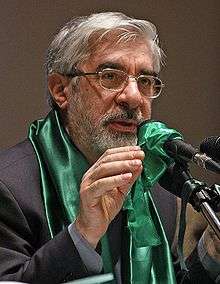Prime Minister of Iran
| Prime Minister of Iran | |
|---|---|
|
Official Standard (1979-1989) | |
 | |
| Residence | Golestan Palace |
| Appointer | Parliament of Iran |
| Precursor | Office created |
| Formation | 1 August 1906 |
| First holder | Mirza Nasrullah Khan |
| Final holder | Mir-Hossein Mousavi |
| Abolished | 3 August 1989 |
| Succession | Office abolished |
| This article is part of a series on the |
| Politics of the Islamic Republic of Iran |
|---|
 |
| Government of Islamic Republic of Iran |
|
Supreme Councils |
|
Local governments |
|
|
|
The Prime Minister of Iran was a political post in Iran that had existed during several different periods of time starting with the Qajar era (when the country was internationally known as Persia) until its most recent revival from 1979 to 1989 following the Iranian Revolution.
Prime Ministers of Qajar era
In the Qajar era, prime ministers were known by different titles. The post itself was mainly known as ataabak or ataabak-e a'zam (grand ataabak), or sometimes sadr-e a'zam (premier) at the beginning, but became ra'is ol-vozaraa (head of ministers) at the end. The title of nakhost vazir (prime minister) was rarely used. The prime minister was usually called by the honorific title hazrat-e ashraf. Reza Khan Sardar Sepah became the last prime minister of the Qajar dynasty in 1923.
For a list of Iranian 'prime ministers' prior to 1907 see List of Premiers of Iran (1699-1907).
Prime Ministers of Pahlavi era
In 1925, Reza Shah became Shah of Iran. He installed Mohammad-Ali Foroughi as the prime minister.[1] In 1941 his son Mohammad Reza Pahlavi became Shah. He installed Mohammad-Ali Foroughi as the prime minister too. In 1951, Mohammed Mosaddeq became Prime Minister but was overthrown in a coup d'état in 1953. Amir-Abbas Hoveyda became Prime minister of Iran in 1965 and remained in office until 1977. Shapour Bakhtiar was the last prime minister of Pahlavi era.
Prime Ministers of Islamic Republic of Iran
After the Iranian Revolution of 1979, Ayatollah Khomeini installed Mehdi Bazargan as the Prime Minister of an interim government, which served until November 1979. The government resigned during the Iran hostage crisis, but mentioned that it has not been the sole reason, and the decision for mass resignation had been reached one day before the invasion of the United States embassy by the Iranian students.
The post was left empty until Abolhassan Banisadr became president in January 1980 and chose Mohammad Ali Rajai as his prime minister, mainly because of pressures imposed by Majlis representatives, specially those close to Islamic Republic Party. Rajai served in the post until Banisadr's impeachment in June, 1981, and was elected as president in the elections of July 24, 1981. Rajai chose Mohammad Javad Bahonar as his prime minister, but they were assassinated together in Prime Minister's office only a few weeks later, on August 30, 1981.
When Ali Khamenei became president in the elections of October, 1981, he first introduced right-leaning Ali Akbar Velayati to the Majlis as his prime minister, but he was voted down by the then left-leaning majority of the parliament, which then forced their own preferred prime minister to Khamenei, namely Mir-Hossein Mousavi. The dispute was finally ended by interference of the Supreme Leader, Ayatollah Khomeini, who advised the president to accept Mousavi.
Mousavi served under the title until 1989, when the constitution was amended to remove the title of Prime Minister and divide his responsibilities between the president and a newly created title of First Vice President.
Living former Prime Ministers
| Name | Picture | Term | Date of birth |
|---|---|---|---|
| Mir-Hossein Mousavi |  |
1981–1989 | 2 March 1942 |
See also
- List of Prime Ministers of Iran
- List of Premiers of Iran (1699-1907)
- Politics of Iran
- President of Iran
- History of Iran
References
- ↑ Gholam Reza Afkhami (27 October 2008). The Life and Times of the Shah. University of California Press. p. 35. ISBN 978-0-520-25328-5. Retrieved 4 November 2012.
Sources
- For a full list of Viziers of Iran in the last 2000 years, see: "Iranian Viziers: From Bozorgmehr to Amir Kabir" (وزیران ایرانی از بزرگمهر تا امیر کبیر) by Abdolrafi' Haqiqat (عبدالرفیع حقیقت). Perry-Castañeda Library collection DS 271 F34 1995
- Mohammad Taghi Bahar, Taarikh-e Mokhtasar-e Ahzaab-e Siaasi-e Iraan (A Short History of Political Parties of Iran), Amirkabir, 1978.
- Encyclopædia Iranica's entries on "Ala-al-Saltana, Mohammad-Ali" and "Akbar Sepahdar-e Azam, Fathallah"
- various articles in The Persian Encyclopedia
- 'Alí Rizā Awsatí (عليرضا اوسطى), Iran in the Past Three Centuries (Irān dar Se Qarn-e Goz̲ashteh - ايران در سه قرن گذشته), Volumes 1 and 2 (Paktāb Publishing - انتشارات پاکتاب, Tehran, Iran, 2003). ISBN 964-93406-6-1 (Vol. 1), ISBN 964-93406-5-3 (Vol. 2).
| Order of precedence | ||
|---|---|---|
| Preceded by Premier of Iran |
Head of Government of Iran 1906 - 1989 |
Succeeded by President of Iran |